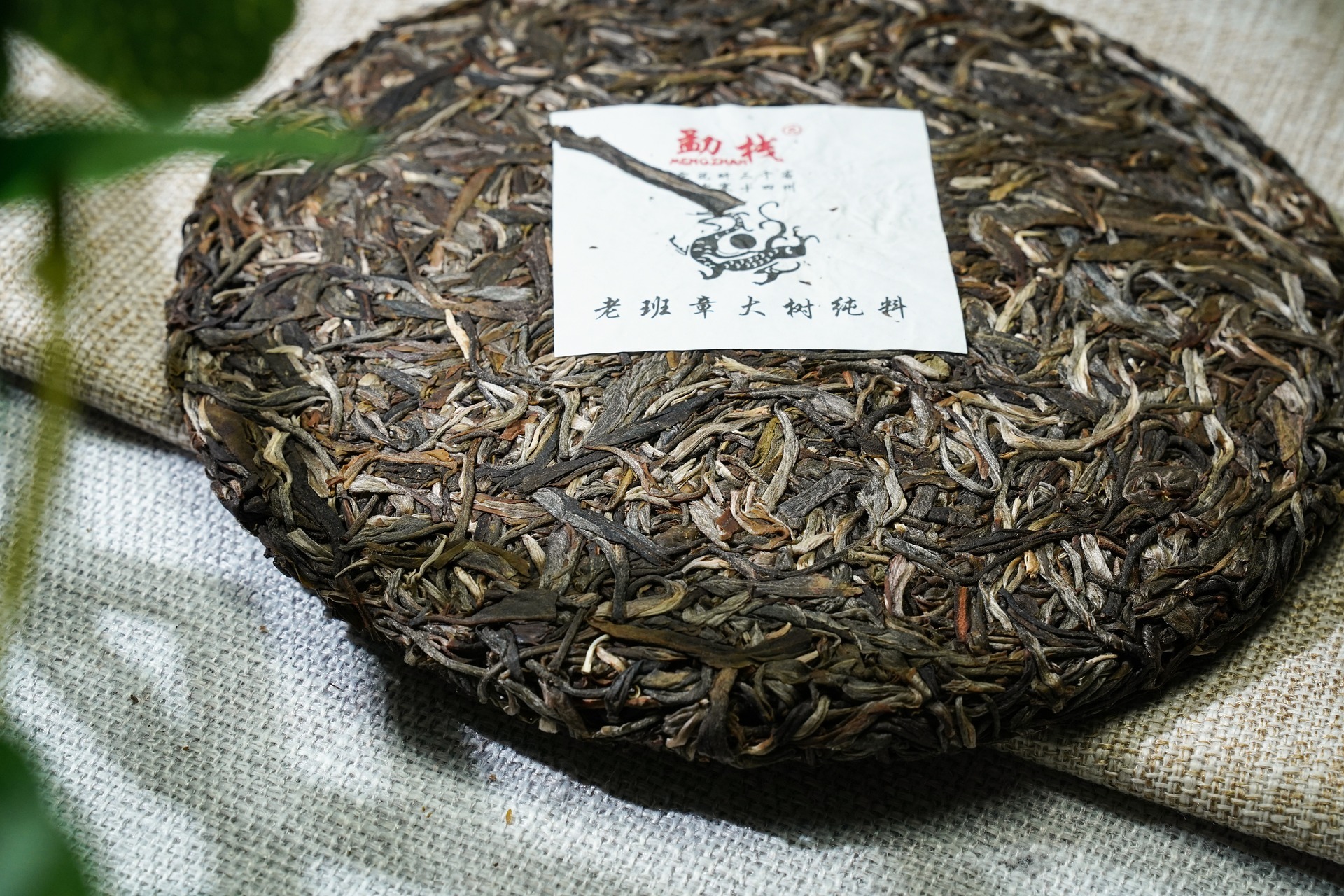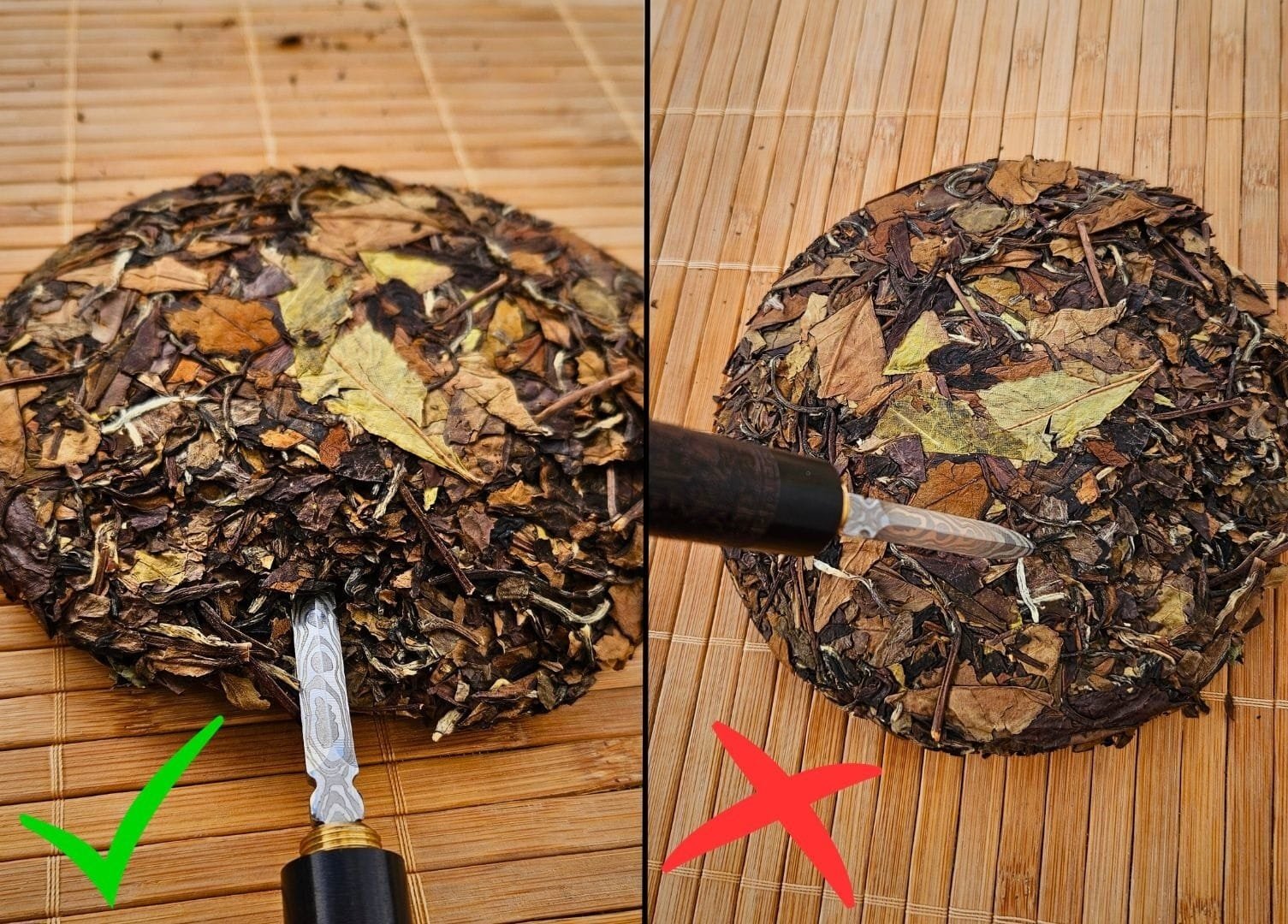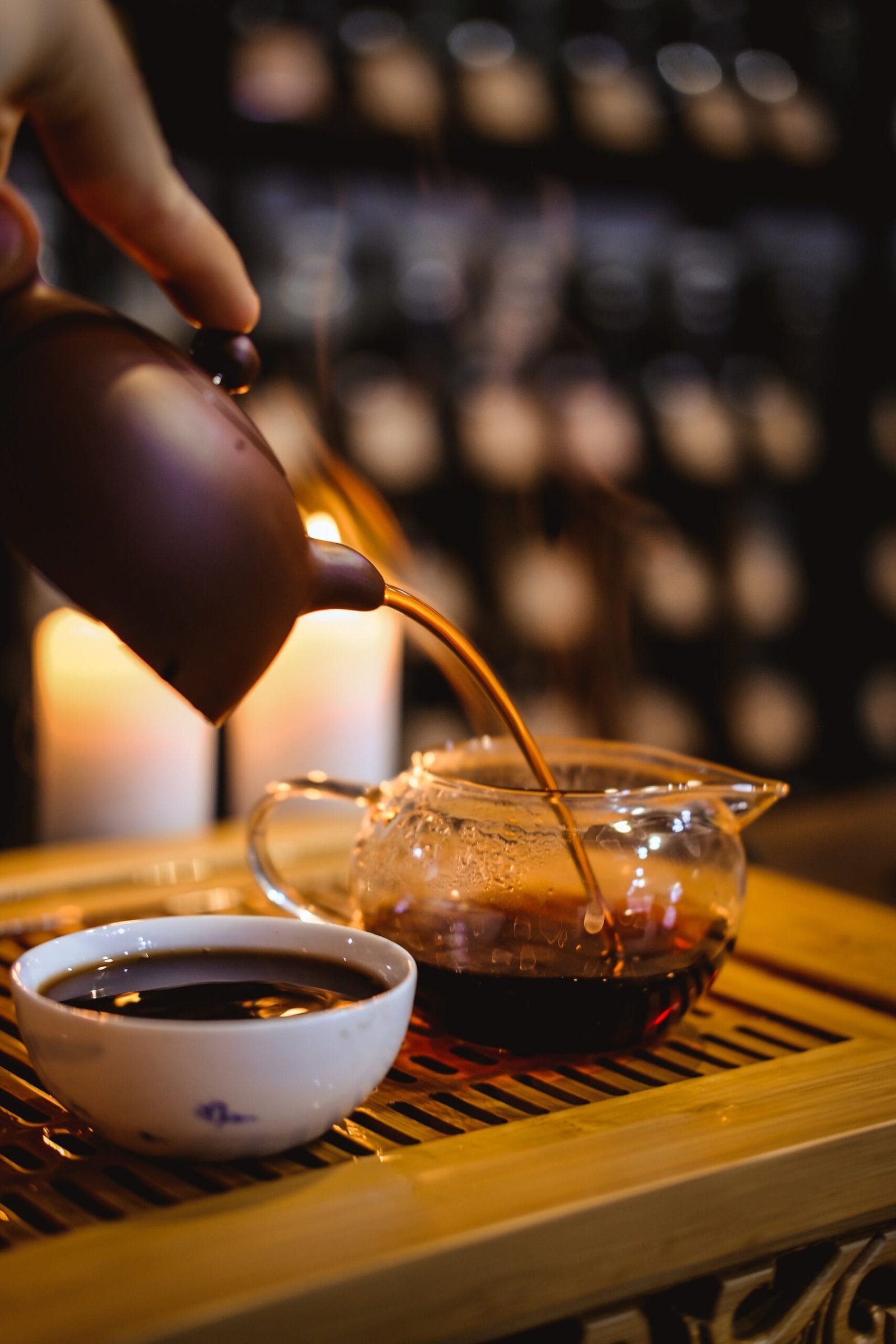Pu Erh tea is an experience. A flavorful journey through the different aromas that develop with every infusion. Look forward to an extraordinary pleasure that no other type of tea can offer. And the best thing is: Pu-erh tea is not only delicious, but also extremely healthy. With every sip you can benefit from the positive Pu Erh tea properties.
In this article, you will learn everything you need to know about preparing Pu Erh tea. I will show you a simple method of preparation and the traditional Chinese method of preparing Pu Erh. You will also find valuable tasting tips that will take your tea drinking experience to a whole new level.

We’ll start with the preparation tips shortly. First, a brief introduction to what exactly Pu Erh tea is. If you already know this, you can also jump directly to the preparation.
Inhalt
ToggleWhat is Pu Erh Tea?
Pu Erh tea, unique in its flavor complexity and variety, originally comes from the province of Yunnan in southwest China. Pu Erh is a protected term. Only teas that come from tea trees in this region may be called Pu Erh. Pu Erh is made from the same plant, Camellia Sinensis, as the other tea varieties (green tea, black tea, Oolong tea, White tea and yellow tea). Pu Erh tea is also referred to as a dark tea due to its post-fermentation process and aging, which give the liquor a very dark color.
Pu Erh tea gets its special taste and health benefits from fermentation. There are two types of Pu Erh tea that differ in the fermentation process: Raw Pu Erh (Sheng) and ripe Pu Erh (Shou / Shu). The two often differ quite significantly in taste. If you are drinking Pu Erh tea for the first time, I recommend starting with a Raw Sheng Pu Erh. In my experience, this often offers a more pleasant and exciting taste for beginners than Shu Pu Erh. In this article you’ll learn more about the differences of the two types, learn how to find good quality and get recommendations for buying Pu Erh.
- Sheng Pu Erh is fermented over many months or even years. This results in a very deep and varied flavor profile.
- Fermentation is accelerated to produce Ripe (Shu) Pu Erh. To do this, the leaves are covered with damp cloths and stacked in a warm room. In this case, after a few weeks, the maturing process is already so advanced that the tea can be brought to market. This often makes it more affordable than Sheng Pu Erh teas.

- Guaranteed Quality and Freshness
- Secure Payment
- Fast Shipping
Tobias
How to Prepare Pu Erh Tea Cake – Separating the Leaves
The leaves are often pressed into a cake or block form for storage and better fermentation. The correct handling of such a so-called tea cake is crucial in order to preserve the quality and unique taste of Pu-erh tea. This is because if the leaves break, the tea infusion often becomes bitter and the individual flavors are extracted too quickly. So how do you remove the required amount of leaves?
The shapes are often very compactly pressed together. You therefore need sharp tools to get between the layers of leaves. There are special tea tools for this: a Pu Erh knife or a tea needle. I recommend that you buy such a tool, as it can make your life much easier when preparing Pu Erh tea. If you don’t have a tea needle at hand, you can also use a cutlery knife or a fork.
To remove the required amount of Pu Erh tea leaves from the cake, start carefully at the edges, as it is usually pressed a little looser here. If you look closely at the tea cake, you can see in which direction the leaves are stacked on top of each other. Carefully insert the tool between the layers of leaves and then lift slightly to loosen the leaves. Under no circumstances should you prick the mold vertically. This will break the leaves. In the next section, we will look at how many leaves you need.

Basics of Brewing Pu Erh Tea
The preparation of Pu Erh tea is an art and offers plenty of scope for experimentation. The traditional Chinese way of preparing Pu Erh tea is called Gong Fu. It is no coincidence that the term is similar to the martial art of Kung Fu. It is literally the same term. The translation is interpreted as “skill acquired through hard work and practice”. In the context of tea, Gong Fu means preparing the tea with great care, precision and dedication, paying careful attention to every detail, from the water temperature to the brewing time. The aim is to bring out the best taste and aroma of the tea. While the Gong Fu style is deeply rooted in Chinese tea culture, the Western style has established itself as a practical alternative. For the sake of completeness, I will also describe the somewhat simpler Western style method below. However, I would highly recommend that you try the traditional Chinese Gong Fu preparation. More than with any other type of tea, Pu Erh benefits from Gong Fu brewing. With the Gong Fu method, you use less water with more tea leaves. In return, you drastically reduce the infusion time. This gives you significantly more infusions, each of which draws a slightly different nuance from the leaves. This method allows the full aroma and taste of the tea to unfold.
A Simple Way for Brewing Pu Erh Tea: Western Method
- Pour approx. 3 grams of tea (2-3 teaspoons) into a pot.
- Pour 250 ml of almost boiling water (95 – 100°C) over it.
- Leave the tea to infuse for 2-3 minutes.
- You can repeat the process 3-4 times. Increase the infusion time by one minute with each infusion.
How to Brew Pu Erh Tea Traditionally: Gong Fu Method
- It is best to use a traditional clay teapot for brewing gong fu. It retains the brewing temperature for longer and develops a patina over time, which rounds off the taste.
- Use 5 – 8g (0,18 – 0,28 oz) of tea leaves per 150 ml of water.
- Heat the water to 95 – 100 degrees. For greener Sheng Pu Erhs, you can also start at 80 degrees.
- Pre-heat the empty pot by leaving hot water at 100 degrees in it for a few seconds. You can then use the water to preheat the cups and jug.
- The tea is often “washed” once before the first proper infusion is drunk. You can combine this with warming up the pot. Put the tea leaves in the pot, add the water and pour it off again after a few seconds.
- For the first proper infusion, leave the tea to infuse for 25-30 seconds.
- When pouring, make sure that you distribute the tea evenly between the cups. The last sip in the pot has a much more intense taste than the first sip. It is therefore very important that you always pour one sip into each cup in turn. It is easier if you first pour the entire tea into a decanter (also known as a Gong Da Bei).
- Enjoy your delicious drink and repeat the process until the tea leaves no longer give off any flavor. With good quality Pu Erh tea, you will get at least 8 infusions. Often even significantly more.
- Increase the infusion time by 5 seconds for each round.
Choosing the Right Water

Considering that water makes up 99% of the finished beverage, it is logical that the quality of the water plays a vital role in the taste of your Pu Erh tea. Soft, slightly mineralized water is ideal to bring out the subtle flavours of the tea. The water should be fresh, i.e. it should not be left in the kettle for too long and should have a high oxygen content. Oxygen is lost every time the water is boiled.
So if you want to get the best out of the taste of Pu Erh tea, I recommend buying a water filter* or using bottled mineral water. Especially if the tap water in your region is very hard.
Tips for Tasting Tea
The traditional Gong Fu preparation of Pu Erh tea emphasizes the mindful and conscious enjoyment of the tea. Try to hold the tea in your mouth for a few seconds and concentrate on the associations that come to mind as you perceive the individual flavors. Do you taste fruit, cocoa or nuts? Perhaps the taste reminds you of the smell of damp forest soil, mushrooms, wood or even leather? With Pu Erh tea, you will often notice a lingering sweetness in the finish. Ripe Shu Pu Erh tea, known for its bold and earthy flavor, offers a different tasting experience compared to raw Pu Erh tea. There is a trick to perceiving the taste more intensely: retro-nasal tasting. If you exhale through your nose while you have the tea in your mouth, you will notice that you can suddenly perceive nuances of taste that you didn’t notice before.
It is exciting to observe how the taste of the tea develops with each infusion. Gradually, different aromas come to the fore. Smell the warm leaves after you have poured out the tea and enjoy the wonderful aroma.
After a few infusions, you will most likely notice a pleasant effect on your body. Of all the teas, Pu Erh generally has the strongest effect on the body. This can range from a relaxing lightness to energetically stimulating. Tea contains an amino acid called L-theanine. Theanine can positively influence brain function and has a calming effect. It is believed that theanine increases the production of alpha waves in the brain, leading to relaxation without drowsiness. It can also support the release of serotonin and dopamine.

Storage of Pu Erh tea
The storage of Pu Erh tea is crucial for its quality and taste. Ideally, it should be stored in a cool, dark and dry place. In contrast to other teas, Pu Erh does not need to be stored completely airtight. A little oxygen can support the maturing process, allowing the tea to develop with age. It is generally advisable to keep the tea in the packaging in which you bought it.
It is important that you keep the tea away from foreign odors. Tea absorbs odors incredibly quickly. Your kitchen is therefore not necessarily the best place to store tea, especially if the packaging is not airtight. Pu Erh tea has a very long shelf life. Under the right storage conditions, its flavors even develop over the years and you can store it for decades.
Summary
Pu Erh tea is a fascinating drink. If you have only ever drunk green or black tea, you should definitely try Pu Erh. It offers a unique experience. However, Pu Erh tea only unfolds its full potential if you prepare and enjoy it consciously. It is better to use the traditional Gong Fu method. With this method, you can prepare so many infusions that you can enjoy the tea throughout the day.
As the tastes of Sheng (Raw) and Shou (Ripe) Pu Erh can differ a lot, I recommend that you get one each in the beginning so that you can get a feel for which kind of Pu Erh suits your taste. In my online shop you can order even small samples, so that you don’t get stuck with big amounts of tea, that you don’t like. Here’s a Sheng and a Shou Pu Erh, that I highly recommend for beginners.
In another article, we dive deeper into different varieties to help you find the right flavor. For beginners, the taste of Pu Erh can sometimes take some getting used to, just like when you drink coffee or beer for the first time. Interesting alternatives with similar health benefits can be oolong tea and white tea.
Frequently Asked Questions
Hochwertiger Pu-Erh Tee kann mehrmals aufgegossen werden, oft 5-10 Mal oder mehr, besonders bei Tees in Kuchen- oder Ziegelsteinform. Jeder Aufguss entfaltet unterschiedliche Geschmacksprofile, und die Stärke des Tees nimmt mit jedem Aufguss allmählich ab.
Die Menge an Pu-Erh Tee, die man sicher pro Tag trinken kann, hängt von individuellen Gesundheitsfaktoren und Koffeinempfindlichkeit ab. Wenn du sehr empfindlich bist, empfiehlt es sich, nicht mehr als 3-4 Tassen pro Tag zu konsumieren, um mögliche Nebenwirkungen von Koffein zu vermeiden. Sprich mit einem Arzt, wenn du blutverdünnende Medikamente einnimmst.


